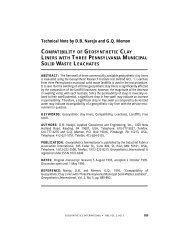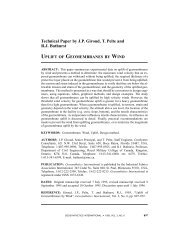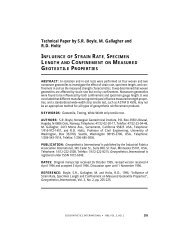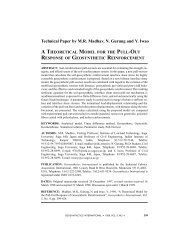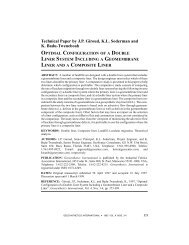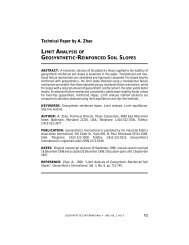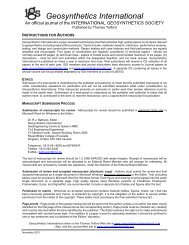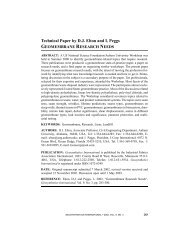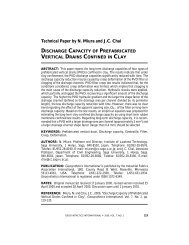strain-softening behavior of waste containment system interfaces
strain-softening behavior of waste containment system interfaces
strain-softening behavior of waste containment system interfaces
You also want an ePaper? Increase the reach of your titles
YUMPU automatically turns print PDFs into web optimized ePapers that Google loves.
Technical Paper by R.B. Gilbert and R.J. Byrne<br />
STRAIN-SOFTENING BEHAVIOR OF WASTE<br />
CONTAINMENT SYSTEM INTERFACES<br />
ABSTRACT: Laboratory test results indicate that many geosynthetic <strong>interfaces</strong> in liners<br />
and covers for <strong>waste</strong> <strong>containment</strong> exhibit <strong>strain</strong>-<strong>s<strong>of</strong>tening</strong> <strong>behavior</strong>. A peak shear<br />
strength is mobilized at small displacements, but post-peak strength reductions occur<br />
with increasing displacement. Mechanisms that contribute to <strong>strain</strong>-<strong>s<strong>of</strong>tening</strong> include<br />
clay particle reorientation, geosynthetic polishing, and geosynthetic failure. Test results<br />
obtained from direct shear and torsional ring shear devices are summarized to illustrate<br />
these mechanisms. The design implications <strong>of</strong> <strong>strain</strong>-<strong>s<strong>of</strong>tening</strong> <strong>behavior</strong> are<br />
then investigated using analytical and numerical models. Deformations in the <strong>waste</strong> under<br />
gravity are sufficient in many cases to limit the available shear resistance along an<br />
interface to less than the peak strength. It is recommended that a factor <strong>of</strong> safety greater<br />
than one be achieved in all <strong>containment</strong> <strong>system</strong> slope designs, assuming that residual<br />
strengths are mobilized along the base <strong>of</strong> the entire <strong>containment</strong> <strong>system</strong>.<br />
KEYWORDS: Slope stability, Geosynthetic <strong>interfaces</strong>, Waste <strong>containment</strong>, Strain-<br />
S<strong>of</strong>tening.<br />
AUTHORS: R.B. Gilbert, Assistant Pr<strong>of</strong>essor <strong>of</strong> Civil Engineering, The University<br />
<strong>of</strong> Texas at Austin, Department <strong>of</strong> Civil Engineering, Cockrell Hall 9.227, Austin,<br />
Texas 78712, USA, Telephone: 1/512-471-4929, Telefax: 1/512-471-6548, and R.J.<br />
Byrne, Principal, Golder Associates Inc., 4104-148 th Avenue N.E., Redmond,<br />
Washington 98052, USA, Telephone: 1/206-883-0777, Telefax: 1/206-882-5498.<br />
PUBLICATION: Geosynthetics International is published by the Industrial Fabrics<br />
Association International, 345 Cedar St., Suite 800, St. Paul, Minnesota 55101, USA,<br />
Telephone: 1/612-222-2508, Telefax: 1/612-222-8215. Geosynthetics International is<br />
registered under ISSN 1072-6349.<br />
DATES: Original manuscript received 2 October 1995, revised version received 15<br />
April 1996 and accepted 19 April 1996. Discussion open until 1 November 1996.<br />
REFERENCE: Gilbert, R.B. and Byrne, R.J., 1996, “Strain-S<strong>of</strong>tening Behavior <strong>of</strong><br />
Waste Containment Interfaces”, Geosynthetics International, Vol. 3, No. 2, pp.<br />
181-203.<br />
GEOSYNTHETICS INTERNATIONAL S 1996, VOL. 3, NO. 2<br />
181
GILBERT AND BYRNE D Strain-S<strong>of</strong>tening <strong>of</strong> Waste Containment System Interfaces<br />
1 INTRODUCTION<br />
Modern <strong>waste</strong> <strong>containment</strong> facilities, such as landfills, <strong>waste</strong> piles and impoundments,<br />
are equipped with multiple-component lining and cover <strong>system</strong>s to contain<br />
<strong>waste</strong> and protect the environment. These <strong>containment</strong> <strong>system</strong>s incorporate a variety<br />
<strong>of</strong> soils and geosynthetics intended to prevent contaminant migration. However, the <strong>interfaces</strong><br />
between the various soil and geosynthetic components may provide limited resistance<br />
to shear. Therefore, <strong>waste</strong> <strong>containment</strong> facilities must be designed to prevent<br />
slope failures resulting from slippage along <strong>containment</strong> <strong>system</strong> <strong>interfaces</strong>.<br />
Recent laboratory shear testing results indicate that many common <strong>interfaces</strong> in<br />
<strong>waste</strong> <strong>containment</strong> <strong>system</strong>s exhibit <strong>strain</strong>-<strong>s<strong>of</strong>tening</strong> <strong>behavior</strong> (Long et al. 1993). A peak<br />
interface shear strength is developed at a small shear displacement, typically less than<br />
approximately 15 mm. With additional shear displacement, the shear strength decreases<br />
and ultimately approaches a residual or minimum value. Analysis <strong>of</strong> a major<br />
slope failure in a <strong>waste</strong> <strong>containment</strong> <strong>system</strong> indicates that <strong>strain</strong>-<strong>s<strong>of</strong>tening</strong> <strong>behavior</strong><br />
contributed to the failure (Byrne et al. 1992; Stark and Poeppel 1994). Peak interface<br />
shear strengths may not be available to resist instability in <strong>waste</strong> <strong>containment</strong> <strong>system</strong>s;<br />
however, designs based on residual strengths may be excessively conservative and costly.<br />
In this paper, the causes and design implications <strong>of</strong> <strong>strain</strong>-<strong>s<strong>of</strong>tening</strong> <strong>behavior</strong> for <strong>containment</strong><br />
<strong>system</strong> <strong>interfaces</strong> are addressed. Laboratory test results are summarized for<br />
typical <strong>containment</strong> <strong>system</strong> <strong>interfaces</strong> that exhibit <strong>strain</strong>-<strong>s<strong>of</strong>tening</strong> <strong>behavior</strong>. Design<br />
implications <strong>of</strong> <strong>strain</strong>-<strong>s<strong>of</strong>tening</strong> <strong>behavior</strong> are then investigated using a one-dimensional<br />
analytical model, and a two-dimensional numerical model.<br />
2 REVIEW OF PREVIOUS RESEARCH ON STRAIN-SOFTENING SOILS<br />
The potential for reductions in shearing resistance with deformation in soils has been<br />
studied and well documented over the past 60 years. Hvorslev (1936) performed torsional<br />
ring shear tests on remolded clay specimens and measured residual shear<br />
strengths as small as 70% <strong>of</strong> the peak shear strength. Skempton (1964) presented direct<br />
shear test results for an overconsolidated clay that indicated a post-peak strength reduction.<br />
Skempton attributed this “<strong>strain</strong>-<strong>s<strong>of</strong>tening</strong>” <strong>behavior</strong> to: (i) an increase <strong>of</strong> water<br />
content in the failure zone due to dilation during shear; and (ii) reorientation <strong>of</strong> “flaky<br />
clay particles” parallel to the direction <strong>of</strong> shear. Bishop et al. (1971) presented torsional<br />
ring shear test results for five plastic clays that exhibit significant post-peak reductions<br />
in strength. In addition to dilation and clay particle reorientation, the authors included<br />
the loss <strong>of</strong> cementation bonds with displacement as a mechanism to explain <strong>strain</strong>-<strong>s<strong>of</strong>tening</strong>.<br />
Many investigators have also concluded that <strong>strain</strong>-<strong>s<strong>of</strong>tening</strong> <strong>behavior</strong> in soils can<br />
lead to slope instability. Skempton (1964) analyzed seven failures <strong>of</strong> natural and excavated<br />
slopes in overconsolidated clays, and estimated that the available shear resistance<br />
along the failure surface was less than the peak strength and near the residual strength<br />
in most cases. Bjerrum (1967) summarized data from 60 slope failures in plastic clays,<br />
concluding that many <strong>of</strong> the failures could not be explained with peak shear strengths<br />
alone. Lefebvre (1982) demonstrated that post-peak strengths provide the best estimate<br />
182 GEOSYNTHETICS INTERNATIONAL S 1996, VOL. 3, NO. 2
GILBERT AND BYRNE D Strain-S<strong>of</strong>tening <strong>of</strong> Waste Containment System Interfaces<br />
<strong>of</strong> the available shear resistance for natural clay slopes in eastern Canada. La Rochelle<br />
(1988, Chapter 15) contended, “... the peak strength cannot be relied upon when dealing<br />
with problems <strong>of</strong> stability in <strong>strain</strong>-<strong>s<strong>of</strong>tening</strong> soils.”.<br />
Skempton (1964) ascribed observed reductions in the available shear resistance to a<br />
progressive failure mechanism. Exceedance <strong>of</strong> the peak strength at any point along a<br />
failure surface will “throw additional stress” to adjacent points due to <strong>strain</strong>-<strong>s<strong>of</strong>tening</strong>.<br />
This additional stress can trigger <strong>strain</strong>-<strong>s<strong>of</strong>tening</strong> at the adjacent points. As a result, the<br />
available shear resistance along the slip surface will approach the residual strength <strong>of</strong><br />
the soil. Bjerrum (1967) provided a qualitative evaluation <strong>of</strong> progressive failure mechanisms,<br />
while numerical models have been used to provide quantitative evaluations<br />
(Duncan and Dunlop 1969; Lo and Lee 1973; Law and Lumb 1978; Chowdhury and<br />
Grivas 1982; Wiberg et al. 1990). These studies indicated that the potential for progressive<br />
failure depends on the initial distribution <strong>of</strong> stress and <strong>strain</strong> in the slope and the<br />
shape <strong>of</strong> the shear stress versus displacement relationship for the soil. The available<br />
strength in <strong>strain</strong>-<strong>s<strong>of</strong>tening</strong> soils may also deteriorate with time because <strong>of</strong> weathering<br />
and creep (Casagrande and Wilson 1951; Bjerrum 1967; Singh and Mitchell 1969; Nelson<br />
and Thompson 1977).<br />
3 STRAIN-SOFTENING OF CONTAINMENT SYSTEM INTERFACES<br />
3.1 Introduction<br />
Strain-<strong>s<strong>of</strong>tening</strong> is prevalent in many <strong>waste</strong> <strong>containment</strong> <strong>system</strong> <strong>interfaces</strong>. Laboratory<br />
shear test results reported for typical <strong>interfaces</strong> that exhibit varying degrees <strong>of</strong><br />
<strong>strain</strong>-<strong>s<strong>of</strong>tening</strong> are summarized in Table 1. In order to quantify the magnitude and rate<br />
<strong>of</strong> <strong>strain</strong>-<strong>s<strong>of</strong>tening</strong>, the shear stress, τ, versus displacement, δ, relationships have been<br />
approximated with a linear model (Figure 1). The magnitude <strong>of</strong> <strong>strain</strong>-<strong>s<strong>of</strong>tening</strong> is described<br />
by the ratio <strong>of</strong> residual to peak strength:<br />
ζ = τ r<br />
τ p<br />
(1)<br />
In cases where the displacement limit <strong>of</strong> the test device did not allow for mobilization<br />
<strong>of</strong> a residual strength, the residual strength was estimated from extrapolation to the<br />
asymptote (Figure 1).<br />
The initial slope <strong>of</strong> the shear stress versus displacement curve is represented by τ p /δ p ,<br />
while the slope <strong>of</strong> the post-peak portion <strong>of</strong> the curve is represented by (τ r - τ p )/(δ r - δ p ).<br />
The value <strong>of</strong> δ r was estimated such that the area under the actual stress-displacement<br />
curve is comparable to that under the linear model (Figure 1). A non-dimensional measure<br />
for the slope (or rate) <strong>of</strong> post-peak strength reduction relative to the initial, pre-peak<br />
slope is given as follows:<br />
Ω = − (τ r − τ p )∕(δ r − δ p )<br />
τ p ∕δ p<br />
(2)<br />
GEOSYNTHETICS INTERNATIONAL S 1996, VOL. 3, NO. 2<br />
183
GILBERT AND BYRNE D Strain-S<strong>of</strong>tening <strong>of</strong> Waste Containment System Interfaces<br />
(δ p , τ p )<br />
Measured<br />
Linear model<br />
Shear stress, (kPa)<br />
τ<br />
(δ r , τ r )<br />
Normal stress = 410 kPa<br />
Displacement, δ (mm)<br />
Figure 1. Large-scale direct shear test results on smooth geomembrane/compacted clay<br />
liner interface (Byrne et al. 1992).<br />
As Ω increases, the rate <strong>of</strong> post-peak strength reduction with displacement increases.<br />
3.2 Mechanisms <strong>of</strong> Strain-S<strong>of</strong>tening<br />
Mechanisms that may contribute to <strong>strain</strong>-<strong>s<strong>of</strong>tening</strong> at <strong>containment</strong> <strong>system</strong> <strong>interfaces</strong><br />
include the following: (i) reorientation <strong>of</strong> clay particles parallel to the direction <strong>of</strong><br />
shearing; (ii) polishing <strong>of</strong> geosynthetic interface surfaces; and (iii) mechanical failure<br />
<strong>of</strong> a geosynthetic component at the interface.<br />
3.2.1 Clay Particle Reorientation<br />
Compacted clay liners are commonly constructed using medium to high plasticity<br />
clays to achieve low hydraulic conductivity. As reported by many others in the past<br />
(Skempton 1964; Bishop et al. 1971; Stark and Eid 1994), plastic clays are susceptible<br />
to <strong>strain</strong>-<strong>s<strong>of</strong>tening</strong> because they generally contain flexible, plate-shaped clay particles.<br />
With shear deformation, these particles tend to align parallel to the direction <strong>of</strong> shear,<br />
reducing the available shear resistance.<br />
Strain-<strong>s<strong>of</strong>tening</strong> due to clay particle reorientation has been observed at <strong>interfaces</strong> between<br />
geomembranes and clay liners (see appended Table 1). Striations on the clay surface<br />
at the completion <strong>of</strong> shear provide evidence that clay particle reorientation has contributed<br />
to the post-peak strength loss. Such striations have been observed both in the<br />
field and laboratory after shear (Byrne et al. 1992).<br />
The magnitude <strong>of</strong> <strong>strain</strong>-<strong>s<strong>of</strong>tening</strong> due to clay particle reorientation is affected by the<br />
compacted moisture content <strong>of</strong> the clay. Byrne et al. (1992) presented data indicating<br />
184 GEOSYNTHETICS INTERNATIONAL S 1996, VOL. 3, NO. 2
GILBERT AND BYRNE D Strain-S<strong>of</strong>tening <strong>of</strong> Waste Containment System Interfaces<br />
that the peak strength <strong>of</strong> a smooth geomembrane/compacted clay liner interface decreased<br />
more rapidly with increasing moisture content than did the residual strength for<br />
moisture contents wet <strong>of</strong> optimum. Hence, ζ values increased with increasing moisture<br />
content.<br />
The magnitude <strong>of</strong> <strong>strain</strong>-<strong>s<strong>of</strong>tening</strong> at the geomembrane/clay interface may be greater<br />
than within the clay. Stark and Poeppel (1994) used a torsional shear device to measure<br />
residual strengths in a plastic clay liner that were about 90% <strong>of</strong> the peak strengths (i.e.<br />
ζ = 0.9). At the interface between a smooth geomembrane and the same clay liner, ζ<br />
values were approximately 0.6. Two possible explanations for this <strong>behavior</strong> are: (i) the<br />
flat geomembrane surface enhances the reorientation <strong>of</strong> clay particles; and (ii) polishing<br />
<strong>of</strong> the geomembrane surface during shear contributes to the post-peak strength loss.<br />
3.2.2 Geosynthetic Polishing<br />
Geosynthetics are polished during shear. Interfaces with smooth and textured geomembranes<br />
exhibit post-peak strength reductions due to geomembrane polishing<br />
(Table 1). Smooth geomembranes apparently have a small-scale roughness (Vallejo and<br />
Zhou 1995) that is reduced or polished during shear. This polishing action is evident<br />
by the shiny appearance and formation <strong>of</strong> striations on smooth geomembranes during<br />
shear (Byrne et al. 1992). The magnitude <strong>of</strong> post-peak strength reduction due to polishing<br />
alone can be significant. For example, geomembrane polishing is the primary mechanism<br />
for <strong>strain</strong>-<strong>s<strong>of</strong>tening</strong> at the nonwoven geotextile/smooth geomembrane interface;<br />
ζ values range between 0.62 and 0.81 in Table 1 for this interface.<br />
Similar <strong>behavior</strong> occurs at <strong>interfaces</strong> with textured geomembranes. Direct shear tests<br />
were conducted on the interface between a nonwoven geotextile and a textured geomembrane<br />
(Li 1995). The geomembrane was made from high density polyethylene<br />
(HDPE), and the textured surface was developed through a coextrusion process. The<br />
nonwoven geotextile was a continuous filament, needle-punched geotextile made from<br />
polyester, and had a mass per unit area <strong>of</strong> 400 g/m 2 . The geomembrane specimens were<br />
circular with a diameter <strong>of</strong> 60 mm, while the geotextile specimens were square with a<br />
length <strong>of</strong> 240 mm. The displacement limit <strong>of</strong> the device was 25 mm. Accumulated shear<br />
displacements were developed by: removing the normal load after shearing a distance<br />
<strong>of</strong> 25 mm; removing the upper, circular shear box and returning it to its starting location;<br />
reapplying the normal load; and then continuing the shear displacement. After each 25<br />
mm increment <strong>of</strong> shear, the nonwoven geotextile specimen was replaced but the textured<br />
geomembrane specimen was not.<br />
The measured shear resistance versus displacement for each increment <strong>of</strong> continuous<br />
displacement is shown in Figure 2a. Post-peak strength reductions after accumulated<br />
displacements <strong>of</strong> 140 mm were substantial, with ζ values <strong>of</strong> approximately 0.6 (Table<br />
1). Also, the peak strength was not re-mobilized after replacing the geotextile at each<br />
25 mm increment <strong>of</strong> displacement (Figure 2a). These results indicate that geomembrane<br />
polishing may have a significant <strong>strain</strong>-<strong>s<strong>of</strong>tening</strong> effect on this nonwoven geotextile/textured<br />
geomembrane interface.<br />
For comparison purposes, a continuous displacement test was performed on the same<br />
interface using a double-interface shear device (Gilbert et al. 1995). The textured geomembrane<br />
specimens were 100 mm in length, and they were sheared over 300 mm long<br />
geotextile specimens. The results shown in Figure 2a indicate that similar <strong>behavior</strong> was<br />
GEOSYNTHETICS INTERNATIONAL S 1996, VOL. 3, NO. 2<br />
185
GILBERT AND BYRNE D Strain-S<strong>of</strong>tening <strong>of</strong> Waste Containment System Interfaces<br />
(a)<br />
(b)<br />
Displacement, δ (mm)<br />
Shear stress, (kPa)<br />
τ<br />
Shear stress, (kPa)<br />
τ<br />
Displacement, δ (mm)<br />
Figure 2. Accumulated displacement results from direct shear tests on a nonwoven<br />
geotextile/textured geomembrane interface: (a) geotextile replaced after each 25 mm<br />
increment; (b) geomembrane replaced after each 25 mm increment.<br />
Note: σ = normal stress.<br />
186 GEOSYNTHETICS INTERNATIONAL S 1996, VOL. 3, NO. 2
GILBERT AND BYRNE D Strain-S<strong>of</strong>tening <strong>of</strong> Waste Containment System Interfaces<br />
obtained in the accumulated and continuous displacement tests. However, the true residual<br />
strength may not have been mobilized, even in the continuous displacement test,<br />
because continuous displacement <strong>of</strong> the geotextile material was limited by the length<br />
<strong>of</strong> the geomembrane specimen.<br />
3.2.3 Geosynthetic Failure<br />
Mechanical failure <strong>of</strong> a geosynthetic component at the interface can lead to large and<br />
sudden reductions in post-peak strength. Two examples <strong>of</strong> this <strong>behavior</strong> are the interface<br />
between a nonwoven geotextile and a textured geomembrane and the interface between<br />
a textured geomembrane and a reinforced geosynthetic clay liner (GCL) (Table<br />
1).<br />
The accumulated displacement tests described above for a nonwoven geotextile/textured<br />
geomembrane interface (Figure 2a) were repeated by replacing the textured geomembrane,<br />
instead <strong>of</strong> the geotextile, after each 25 mm shear increment (Li 1995). The<br />
test results are shown in Figure 2b. The peak strength was reduced after accumulated<br />
displacements, providing evidence <strong>of</strong> strength loss due to geotextile failure (Figure 2b).<br />
This <strong>behavior</strong> is consistent with torsional ring shear test results presented by Stark et<br />
al. (1996) for nonwoven geotextile/textured geomembrane <strong>interfaces</strong>; they observed<br />
fiber alignment, pull-out and filament breakage in scanning electron microscope<br />
photographs <strong>of</strong> the nonwoven geotextiles after shear. However, a comparison <strong>of</strong> Figure<br />
2b (geomembrane replaced) and Figure 2a (geotextile replaced) shows that more <strong>of</strong> the<br />
peak strength was re-mobilized when the geomembrane was replaced. This result indicates<br />
that geomembrane polishing may be more significant for this particular nonwoven<br />
geotextile/textured geomembrane interface at a high normal stress <strong>of</strong> 690 kPa.<br />
Two different failure mechanisms have been identified for the interface between a<br />
textured geomembrane and a reinforced GCL. Gilbert et al. (1996a) tested a GCL that<br />
had a bentonite layer encased between a nonwoven geotextile and a woven geotextile.<br />
The bentonite layer was reinforced with polypropylene fibers that were needle-punched<br />
through the bentonite from the nonwoven geotextile into the woven geotextile. The<br />
GCL was hydrated, and the textured geomembrane was then sheared against the woven<br />
geotextile. For normal stresses up to 14 kPa, the shear surface formed at the interface<br />
between the textured geomembrane and woven geotextile. Post-peak strength reductions<br />
likely occurred due to a combination <strong>of</strong> geotextile failure at the interface and geomembrane<br />
polishing, with ζ values ranging from 0.65 to 0.70 (Table 1). For normal<br />
stresses greater than 14 kPa, the needle-punched reinforcing fibers pulled out from the<br />
woven geotextile, and shear occurred through the bentonite layer; strengths at large displacements<br />
approached the strength <strong>of</strong> unreinforced bentonite. Post-peak strength reductions<br />
as a result <strong>of</strong> this internal failure mechanism were more severe than at the interface,<br />
with ζ values ranging from 0.33 to 0.57 (Table 1).<br />
Byrne (1994) tested a modified version <strong>of</strong> this reinforced GCL product that had an<br />
adhesive applied to the woven geotextile to prevent fiber pull-out. The stronger bond<br />
between the reinforcing fibers and the woven geotextile prevented a shear failure<br />
through the bentonite, even at normal stresses exceeding 14 kPa. The magnitudes <strong>of</strong><br />
post-peak strength reductions were similar to those obtained on the unmodified version<br />
at lower normal stresses, with ζ values ranging from 0.59 to 0.76 (Table 1). One observation<br />
made during this test was that the peak strength was possibly related to rough-<br />
GEOSYNTHETICS INTERNATIONAL S 1996, VOL. 3, NO. 2<br />
187
GILBERT AND BYRNE D Strain-S<strong>of</strong>tening <strong>of</strong> Waste Containment System Interfaces<br />
ness on the woven geotextile surface due to the protruding needle-punched fibers that<br />
were covered with adhesive. These protuberances were sheared <strong>of</strong>f with displacement,<br />
leading to post-peak reductions in strength (Byrne 1994).<br />
3.3 Discussion <strong>of</strong> Laboratory Test Results<br />
The interface test results described above and summarized in Table 1 indicate that<br />
<strong>strain</strong>-<strong>s<strong>of</strong>tening</strong> effects for <strong>containment</strong> <strong>system</strong> <strong>interfaces</strong> can be substantial. Peak<br />
strengths are mobilized at small displacements between 1 and 15 mm. Strain-<strong>s<strong>of</strong>tening</strong><br />
can lead to post-peak strengths that are as small as 30% <strong>of</strong> the peak strength. The greatest<br />
strength reductions (i.e. the lowest ζ values) are generally associated with polishing<br />
and/or mechanical failure <strong>of</strong> a geosynthetic material. For a given interface, the peak and<br />
residual displacements and the strength reduction factor, ζ, are roughly independent <strong>of</strong><br />
normal stress (Table 1). Hence, the reduction rate factor, Ω, is also approximately independent<br />
<strong>of</strong> normal stress (Table 1). Finally, values for the post-peak strength reduction<br />
rate factor, Ω, vary over several orders <strong>of</strong> magnitude, and the highest reduction rates are<br />
generally associated with geosynthetic failure.<br />
Measurement <strong>of</strong> <strong>strain</strong>-<strong>s<strong>of</strong>tening</strong> <strong>behavior</strong> may be difficult with some test devices<br />
due to displacement limitations (Figure 1). Values for δ r in Table 1 exceed the displacement<br />
limits <strong>of</strong> many test devices. A limited comparison between conventional direct<br />
shear devices (with displacement limitations) and torsional ring shear devices (with unlimited,<br />
continuous displacement) is possible with the data in Table 1. Results are reported<br />
from both devices for the following <strong>interfaces</strong>: smooth geomembrane/compacted<br />
clay; nonwoven geotextile/smooth geomembrane; and nonwoven<br />
geotextile/textured geomembrane. The measured magnitude <strong>of</strong> <strong>strain</strong>-<strong>s<strong>of</strong>tening</strong>, ζ, and<br />
rate <strong>of</strong> <strong>strain</strong>-<strong>s<strong>of</strong>tening</strong>, Ω, are generally smaller for the torsional ring shear device. A<br />
possible explanation for this result is that the true residual strength is not mobilized with<br />
conventional direct shear devices (even with accumulated displacements), and they<br />
therefore provide an unconservative estimate <strong>of</strong> <strong>strain</strong>-<strong>s<strong>of</strong>tening</strong> potential. However,<br />
it is not possible to draw convincing conclusions because different geosynthetic products<br />
and normal stresses were used in the different test programs.<br />
4 DESIGN CONSIDERATIONS FOR STRAIN-SOFTENING<br />
INTERFACES<br />
4.1 General<br />
Slopes in <strong>waste</strong> <strong>containment</strong> <strong>system</strong>s are commonly designed using a limit equilibrium<br />
approach: the available or limiting shear resistance is compared with the shear resistance<br />
required to maintain equilibrium. It is difficult to determine the available shear<br />
resistance along an interface exhibiting <strong>strain</strong>-<strong>s<strong>of</strong>tening</strong> <strong>behavior</strong>. It may be unsafe to<br />
assume that the peak strength is available, while it may be excessively conservative and<br />
costly to assume that only the residual strength is available.<br />
The available shear resistance will depend on deformations in the <strong>containment</strong> <strong>system</strong>.<br />
A simplified cross-section through a typical <strong>containment</strong> <strong>system</strong> slope is shown<br />
in Figure 3. This condition represents a below grade landfill cell during filling or a<br />
188 GEOSYNTHETICS INTERNATIONAL S 1996, VOL. 3, NO. 2
GILBERT AND BYRNE D Strain-S<strong>of</strong>tening <strong>of</strong> Waste Containment System Interfaces<br />
Side<br />
slope<br />
Buttress<br />
f<br />
Ψ<br />
H S<br />
L S<br />
H B<br />
L B<br />
Figure 3.<br />
Simplified, one-dimensional model <strong>of</strong> a <strong>waste</strong> <strong>containment</strong> slope.<br />
closed landfill in a valley. It could also represent a cover slope by replacing the <strong>waste</strong><br />
with soil in the model. The <strong>waste</strong> on the slope is supported by a buttress <strong>of</strong> <strong>waste</strong> at the<br />
toe <strong>of</strong> the slope. The <strong>waste</strong> will compress while transmitting the driving load in the slope<br />
to the buttress, and slippage will occur along the interface to mobilize shear resistance.<br />
As discussed qualitatively by both Skempton (1964) and Bishop (1967), these deformations<br />
may progressively reduce the available shear resistance on the slip surface due to<br />
<strong>strain</strong>-<strong>s<strong>of</strong>tening</strong> <strong>behavior</strong>. A quantitative model for evaluating <strong>strain</strong>-<strong>s<strong>of</strong>tening</strong> effects<br />
on the available shear resistance in liner and cover <strong>system</strong>s is described and applied in<br />
the following sections.<br />
4.2 Analytical Model<br />
4.2.1 Introduction<br />
A simplified, analytical model can provide useful insight into the available shear resistance<br />
along <strong>interfaces</strong> in <strong>containment</strong> <strong>system</strong>s. Gilbert et al. (1996b) developed an<br />
analytical model in which the buttress and side slope are treated as one-dimensional,<br />
elastic columns on <strong>strain</strong>-<strong>s<strong>of</strong>tening</strong> <strong>interfaces</strong> (Figure 3). Strain-<strong>s<strong>of</strong>tening</strong> at the interface<br />
is modeled using a linear representation <strong>of</strong> the stress-displacement relationship<br />
(Figure 1). The effects <strong>of</strong> <strong>strain</strong>-<strong>s<strong>of</strong>tening</strong> are quantified as follows:<br />
R f = s limit<br />
s p<br />
(3)<br />
where: R f = reduction in available shear resistance due to deformations; s limit = average<br />
available shear resistance (i.e. the limiting shear resistance); and s p = average shear resistance<br />
available for an incompressible <strong>waste</strong>. R f can range from 1.0 (the maximum<br />
strength is available) to ζ (only the residual strength is available).<br />
The reduction factor, R f , can be expressed as a function <strong>of</strong> ζ, Ω, and the following<br />
relative stiffness factor:<br />
GEOSYNTHETICS INTERNATIONAL S 1996, VOL. 3, NO. 2<br />
189
GILBERT AND BYRNE D Strain-S<strong>of</strong>tening <strong>of</strong> Waste Containment System Interfaces<br />
M = τ p∕δ p<br />
EH<br />
L 2<br />
(4)<br />
where: M = non-dimensional factor; E = modulus <strong>of</strong> elasticity for the column; H = column<br />
thickness; and L = length <strong>of</strong> the interface along the column base. A detailed derivation<br />
<strong>of</strong> the solution for R f along the buttress and side slope <strong>interfaces</strong> is given by Gilbert<br />
et al. (1996b). The results from this derivation are provided below to study <strong>strain</strong>-<strong>s<strong>of</strong>tening</strong><br />
<strong>behavior</strong> for typical interface properties (Table 1) and to serve as a practical design<br />
guide.<br />
4.2.2 Buttress<br />
The relationship between (R f ) B and ζ Β ,andΩ Β and M B for the buttress (where the subscript<br />
B denotes buttress) is shown in Figure 4. Since the buttress geometry is generally<br />
not a column with a constant height, it is approximated by a column with an equivalent<br />
height, H B , equal to the <strong>waste</strong> height and an equivalent length, L B , such that the volume<br />
<strong>of</strong> <strong>waste</strong> in the column is equal to the volume <strong>of</strong> <strong>waste</strong> in the buttress (Figure 3). These<br />
equivalent geometrical parameters are used in Equation 4 to find M B .AsM B increases,<br />
the available shear resistance along the interface decreases (Figure 4). M B will increase<br />
as: the interface stiffness increases (M B ∝ (τ p /δ p ) B ); the axial stiffness <strong>of</strong> the <strong>waste</strong> decreases<br />
(M B ∝ 1/EH B ); and the length <strong>of</strong> the buttress increases (M B ∝ L 2 B<br />
). For a given<br />
value <strong>of</strong> M B , the available shear resistance decreases as the rate <strong>of</strong> <strong>strain</strong>-<strong>s<strong>of</strong>tening</strong> for<br />
the base interface, Ω Β , increases.<br />
Typical values <strong>of</strong> E for <strong>waste</strong> range from 100 to 10,000 kPa depending on the type<br />
<strong>of</strong> <strong>waste</strong> and placement method (Sharma et al. 1989; Fassett 1993), while L B could range<br />
from 10 to 1000 m and H B could range from 10 to 100 m. When these values are combined<br />
with the range <strong>of</strong> τ p /δ p values compiled in Table 1, possible M B values range from<br />
∞<br />
1<br />
0<br />
Figure 4. Nondimensionalized interface shear resistance reduction factors versus relative<br />
stiffness factor for <strong>waste</strong> buttress.<br />
190 GEOSYNTHETICS INTERNATIONAL S 1996, VOL. 3, NO. 2
GILBERT AND BYRNE D Strain-S<strong>of</strong>tening <strong>of</strong> Waste Containment System Interfaces<br />
0.1to1.0×10 8 . While, Ω values in Table 1 range from 0.006 to 0.3. Therefore, the<br />
available interface shear resistance for a buttress could potentially range from the peak<br />
to the residual shear strength depending on the <strong>waste</strong> properties, interface properties,<br />
and landfill geometry (Figure 4).<br />
The reduction in available shear resistance occurs very quickly with increasing values<br />
<strong>of</strong> M B beyond a limiting M B value for a given Ω Β (Figure 4). This limiting value <strong>of</strong><br />
M B is insensitive to ζ B , and is approximately equal to 1/Ω Β ,forΩ Β ≤ 1. Consequently,<br />
a preliminary design approach is to compare M B with 1/Ω Β by calculating the product<br />
M B Ω Β .IfM B Ω Β > 1, then <strong>strain</strong>-<strong>s<strong>of</strong>tening</strong> effects are likely and the residual interface<br />
shear strength should be used in design. Note that M B Ω Β > 1 is equal to the following:<br />
(τ p − τ r )<br />
> EH B<br />
(δ r − δ p ) L 2<br />
B<br />
B<br />
Hence, the effects <strong>of</strong> <strong>strain</strong>-<strong>s<strong>of</strong>tening</strong> in the buttress are essentially insensitive to the<br />
pre-peak slope <strong>of</strong> the shear resistance versus displacement curve for the base interface,<br />
(τ p /δ p ) B . This conclusion is useful because it may be difficult to determine the peak displacement<br />
accurately in laboratory testing.<br />
4.2.3 Side Slope<br />
(5)<br />
The available shear resistance along the side slope interface (R f ) S is related to ζ S , Ω S<br />
and M S (where the subscript S denotes side slope), as well as the applied shear stress and<br />
the stiffness provided by the buttress at the toe <strong>of</strong> the slope. The column height, normal<br />
stress at the interface and shear stress at the interface all increase down the slope (Figure<br />
3). However, since each <strong>of</strong> these variables is proportional to the <strong>waste</strong> thickness along<br />
the slope for a frictional interface, an equivalent column with constant height, normal<br />
stress and shear stress along the interface can be used to approximate the wedge <strong>of</strong> <strong>waste</strong><br />
on the side slope. A detailed derivation and discussion <strong>of</strong> this approximation are given<br />
in Gilbert et al. (1996b). The equivalent column height, H S , for obtaining M S from Equation<br />
4 is the distance along a line perpendicular to the interface at the toe <strong>of</strong> the side<br />
slope, while the equivalent column length, L S , is the length <strong>of</strong> the side slope interface<br />
(Figure 3).<br />
The applied shear stress along the interface is represented by the following non-dimensional<br />
factor:<br />
β S =<br />
f toe<br />
(τ p ) toe<br />
(6)<br />
where: f toe = applied shear stress at the toe <strong>of</strong> the slope; and (τ p ) toe = peak, interface shear<br />
resistance at the toe. For a frictional interface, β S can be approximated by tanΨ/tan(Ô p ) S ,<br />
where Ψ is the slope angle (Figure 3) and (Ô p ) S is the peak friction angle for the slope<br />
interface. Strain-<strong>s<strong>of</strong>tening</strong> will occur in this model only if β S > 1. The buttress stiffness<br />
is represented by a factor, α S , that relates the stiffness <strong>of</strong> the buttress to that <strong>of</strong> the side<br />
slope. For practical purposes, Gilbert et al. (1996b) show that α S can be approximated<br />
by the following:<br />
GEOSYNTHETICS INTERNATIONAL S 1996, VOL. 3, NO. 2<br />
191
GILBERT AND BYRNE D Strain-S<strong>of</strong>tening <strong>of</strong> Waste Containment System Interfaces<br />
α s ≈ L S<br />
L B<br />
cos 2 θ<br />
(7)<br />
where θ is the orientation <strong>of</strong> the resultant force between the side slope and buttress. A<br />
conservative assumption for θ is the slope angle, Ψ. Typical values <strong>of</strong> α S are close to 1.0.<br />
The relationship between (R f ) S and M S ,andζ S and M S is shown in Figure 5 for given<br />
values <strong>of</strong> β S and α S . Gilbert et al. (1996b) show that (R f ) S is relatively insensitive to β S<br />
(for values greater than 1) and α S . Similar to the buttress case, the reduction in shear<br />
resistance from peak to residual values occurs rapidly with increasing M S once a limiting<br />
value <strong>of</strong> M S is exceeded. However, the limiting M S value for a given Ω S value is<br />
smaller than that for the buttress (Figure 4). Therefore, it is more likely that the residual<br />
strength will be mobilized along the side slope rather than the buttress. Further, given<br />
typical values for M S and Ω S (Table 1), it is unlikely that an average stress greater than<br />
the residual value could be mobilized along a typical side slope in a <strong>containment</strong> <strong>system</strong>.<br />
4.3 Design Example<br />
4.3.1 Introduction<br />
An example <strong>waste</strong> <strong>containment</strong> slope is analyzed in this section to demonstrate how<br />
to: apply the analytical model presented above; compare the simplified, analytical<br />
model results with those from a more sophisticated, numerical model; and gain further<br />
insight into the potential effects <strong>of</strong> <strong>strain</strong>-<strong>s<strong>of</strong>tening</strong> on the available shear resistance in<br />
1<br />
∞<br />
Figure 5.<br />
Interface shear resistance versus relative stiffness factor for <strong>waste</strong> slope.<br />
192 GEOSYNTHETICS INTERNATIONAL S 1996, VOL. 3, NO. 2
GILBERT AND BYRNE D Strain-S<strong>of</strong>tening <strong>of</strong> Waste Containment System Interfaces<br />
<strong>containment</strong> <strong>system</strong>s. The geometry for the example slope is shown in Figure 6. The<br />
length <strong>of</strong> the base is fixed at 91.5 m, and the maximum stable slope height is determined<br />
for various interface and <strong>waste</strong> properties.<br />
The lining <strong>system</strong> along the base and side slope has the same interface properties: a<br />
peak secant friction angle = 9.3_; a residual secant friction angle = 4.1_; andζ =<br />
tan(4.1_)/tan(9.3_) = 0.44. If the peak interface strength is available along both the side<br />
slope and base, then the maximum slope height that is stable (i.e. the slope height with<br />
a factor <strong>of</strong> safety = 1.0) is 28.3 m according to a limit equilibrium analysis based on<br />
Spencer’s method (Spencer 1967). The maximum, stable slope height decreases to 13.1<br />
m if the residual strength is all that is available along both the side slope and base <strong>interfaces</strong>.<br />
Therefore, the maximum stable slope height is between 13.1 and 28.3 m, depending<br />
on deformations within the <strong>system</strong>.<br />
Three different <strong>strain</strong>-<strong>s<strong>of</strong>tening</strong> rates and two different <strong>waste</strong> types are investigated.<br />
The three shear resistance versus displacement curves, which correspond to Ω values<br />
<strong>of</strong> 0.05, 0.005 and 0.001, are shown in Figure 7. These Ω values incorporate the range<br />
<strong>of</strong> typical values for <strong>containment</strong> <strong>system</strong> <strong>interfaces</strong> (Table 1). In each case, the peak<br />
displacement, δ p , is equal to 1.0 mm, the peak secant friction angle, Ô p , is equal to 9.3_,<br />
and the strength reduction factor, ζ, is equal to 0.44. The base and side slope <strong>interfaces</strong><br />
are assumed to have the same stress versus displacement curves (i.e. Ω B = Ω S = Ω). Α<br />
municipal <strong>waste</strong>, with E = 718 kPa and γ = 11.0 kN/m 3 , and a hazardous <strong>waste</strong>, with<br />
E = 7,180 kPa and γ = 17.2 kN/m 3 , are used in the analysis.<br />
4.3.2 Analytical Model Results<br />
The slope configuration at the maximum possible height <strong>of</strong> 28.3 m is adopted as a<br />
nominal slope geometry for the analysis (i.e. to determine L S , H S , L B and H B ). This nominal<br />
geometry is conservative since the smallest R f values will be obtained for the highest<br />
and longest slope. The resulting values for L S , H S , L B and H B are given in appended Table<br />
2.<br />
First, consider the municipal <strong>waste</strong>. For the buttress, the peak shear resistance on the<br />
base, (τ p ) B , is equal to the normal stress on the landfill base multiplied by tanÔ p . Hence,<br />
(τ p ) B = (28.3 m)(11.0 kN/m 3 )tan(9.3_) = 51 kPa. Further, M B is obtained from Equation<br />
4 as follows:<br />
(51 kPa)∕(0.001 m)<br />
M B = (8)<br />
(718 kPa)(28.3 m) (49.0 m)2 ≈ 6, 000 m 2<br />
Vertical distance (m)<br />
1V:2H<br />
Side<br />
slope<br />
Buttress<br />
1V:3H<br />
Horizontal distance (m)<br />
Figure 6.<br />
Configuration <strong>of</strong> <strong>waste</strong> <strong>containment</strong> slope for design example.<br />
GEOSYNTHETICS INTERNATIONAL S 1996, VOL. 3, NO. 2<br />
193
GILBERT AND BYRNE D Strain-S<strong>of</strong>tening <strong>of</strong> Waste Containment System Interfaces<br />
Figure 7.<br />
Secant friction angle versus displacement curves for <strong>interfaces</strong> in design example.<br />
Since the product M B Ω B exceeds 1 for all values <strong>of</strong> Ω B greater than 0.0002 (Table 2),<br />
there is a high potential for strength reductions due to <strong>strain</strong>-<strong>s<strong>of</strong>tening</strong> for all <strong>of</strong> the<br />
<strong>strain</strong>-<strong>s<strong>of</strong>tening</strong> curves in Figure 7. In fact, the values <strong>of</strong> (R f ) B for the buttress estimated<br />
from Figure 4 are all significantly less than 1.0, ranging from 0.49 to 0.61 (Table 2).<br />
As Ω B decreases, the magnitude <strong>of</strong> (R f ) B increases. For the slope, M S = 8000, β S =3.1_<br />
from Equation 6, and α S = 1 from Equation 7. The resulting reduction factor, obtained<br />
from Figure 5, is equal to its smallest possible value, (R f ) S = ζ S = 0.44, for the three different<br />
Ω S values (Table 2). Therefore, it is unlikely that an average stress greater than the<br />
residual strength will be available along the side slope interface.<br />
Next, consider the hazardous <strong>waste</strong>. Since the hazardous <strong>waste</strong> is stiffer than the municipal<br />
<strong>waste</strong>, deformations will be smaller. For the hazardous <strong>waste</strong>, M B and M S are<br />
about one order <strong>of</strong> magnitude smaller than for the municipal <strong>waste</strong>. Consequently, at<br />
a given value <strong>of</strong> Ω, R f values for the hazardous <strong>waste</strong> are greater than or equal to those<br />
for the municipal <strong>waste</strong> (Table 2). For the buttress, (R f ) B is as large as 0.85 when Ω Β is<br />
equal to its smallest value <strong>of</strong> 0.001. Note that in this case, the product <strong>of</strong> M B Ω Β approaches<br />
a value <strong>of</strong> 1. However, the reduction factor along side slope, (R f ) S , is close to<br />
ζ S for all Ω S values, even with the order <strong>of</strong> magnitude decrease in M S .<br />
4.3.3 NumericalModelResults<br />
A two-dimensional, numerical analysis was performed using the Universal Distinct<br />
Element Code (ITASCA 1993) to verify the analytical results. The <strong>waste</strong> was modeled<br />
as an elastic, Mohr-Coulomb material using the property values given in Table 2. The<br />
shear resistance versus displacement relationships for the side slope and base <strong>interfaces</strong><br />
were modeled using a continuously yielding model (ITASCA 1993). Figure 7 shows the<br />
194 GEOSYNTHETICS INTERNATIONAL S 1996, VOL. 3, NO. 2
GILBERT AND BYRNE D Strain-S<strong>of</strong>tening <strong>of</strong> Waste Containment System Interfaces<br />
three curves that were used corresponding to Ω values <strong>of</strong> 0.05, 0.005 and 0.001. The<br />
<strong>interfaces</strong> were assumed to have an infinite normal stiffness (i.e. they were treated as<br />
rigid boundaries). The <strong>waste</strong> was discretized into 612 quadrilateral elements with 28<br />
contact points along the <strong>interfaces</strong>, and <strong>waste</strong> placement was modeled as an instantaneous<br />
process. The significant improvements in the numerical model versus the analytical<br />
model are: (i) <strong>waste</strong> deformations were modeled in two dimensions versus one dimension;<br />
(ii) the <strong>waste</strong> was modeled as a continuum instead <strong>of</strong> individual columns on<br />
the base and side slope; and (iii) the interface shear resistance versus displacement relationships<br />
were more realistically modeled by nonlinear functions (Figure 7) rather than<br />
linear functions.<br />
The maximum, stable slope height was determined using the numerical model for<br />
each <strong>of</strong> the cases analyzed previously, and the results are presented in Table 2. At this<br />
slope height, the mobilized resistances were integrated along the base and side slope<br />
<strong>interfaces</strong> to determine the average resistances and the corresponding values <strong>of</strong> R f from<br />
Equation 3. The analytical and numerical results compare favorably. Both results show<br />
that R f values increase with decreasing Ω values, and increase with increasing <strong>waste</strong><br />
stiffness. In addition, the magnitude <strong>of</strong> R f obtained from the analytical model is within<br />
15% <strong>of</strong> the value obtained from the numerical model. Finally, the estimate <strong>of</strong> R f from<br />
the analytical model is slightly conservative compared to the numerical model.<br />
This example demonstrates the potential for <strong>strain</strong>-<strong>s<strong>of</strong>tening</strong> along <strong>containment</strong> <strong>system</strong><br />
<strong>interfaces</strong> due to deformations within the <strong>waste</strong>. A conventional design approach<br />
for this slope is to apply a factor <strong>of</strong> safety <strong>of</strong> 1.5 to the peak interface strength in a limit<br />
equilibrium analysis. The resulting slope height for this design approach is 22.0 m. In<br />
five <strong>of</strong> the six cases presented in Table 2, this design slope height would have be unstable.<br />
4.4 Design Recommendations<br />
The analytical and numerical results presented in this paper indicate that reductions<br />
in the available interface strength from peak to residual values are likely due to deformations<br />
in an elastic <strong>waste</strong> material under gravity. Since typical <strong>waste</strong> materials are<br />
not elastic and exhibit reductions in stiffness at large <strong>strain</strong>s, the potential for <strong>strain</strong><strong>s<strong>of</strong>tening</strong><br />
reductions may even be greater. In addition, other factors exist that might<br />
cause <strong>strain</strong>-<strong>s<strong>of</strong>tening</strong> reductions in resistance such as: high, localized stresses imposed<br />
during construction; creep along the interface or within the <strong>containment</strong> <strong>system</strong> components;<br />
<strong>waste</strong> settlement; and foundation settlement. Therefore, it is strongly recommended<br />
that the potential for instability be explored in a limit equilibrium analysis using<br />
residual strengths along all <strong>interfaces</strong>. The factor <strong>of</strong> safety against failure for this<br />
analysis should be greater than one unless the consequences <strong>of</strong> failure are not significant<br />
or a reliance on greater strengths is clearly justified.<br />
Consideration <strong>of</strong> residual strengths may significantly reduce the maximum allowable<br />
grade or length <strong>of</strong> slopes in a given design. In the example presented previously, the<br />
design slope height would be 13.1 m versus the 22.0 m height obtained using peak<br />
strengths with a factor <strong>of</strong> safety equal to 1.5. One approach to reduce the effect <strong>of</strong> <strong>strain</strong><strong>s<strong>of</strong>tening</strong><br />
is to isolate the <strong>strain</strong>-<strong>s<strong>of</strong>tening</strong> interface by including an overlying interface<br />
with a smaller peak strength. This approach is only useful if the shear strength <strong>of</strong> the<br />
upper interface is significantly greater than the residual strength <strong>of</strong> the <strong>strain</strong>-<strong>s<strong>of</strong>tening</strong><br />
GEOSYNTHETICS INTERNATIONAL S 1996, VOL. 3, NO. 2<br />
195
GILBERT AND BYRNE D Strain-S<strong>of</strong>tening <strong>of</strong> Waste Containment System Interfaces<br />
interface. A second design approach is to include a stiff component, such as a geogrid,<br />
above the interface <strong>of</strong> concern. This stiff component will increase the effective axial<br />
stiffness <strong>of</strong> the overlying material, decreasing the level <strong>of</strong> deformation (e.g. M B in Figure<br />
4 and M S in Figure 5 are reduced).<br />
5 CONCLUSIONS<br />
The laboratory test results summarized in this paper demonstrate that many geosynthetic<br />
<strong>interfaces</strong> in <strong>waste</strong> <strong>containment</strong> <strong>system</strong>s exhibit <strong>strain</strong>-<strong>s<strong>of</strong>tening</strong> <strong>behavior</strong>. The<br />
mechanisms leading to <strong>strain</strong>-<strong>s<strong>of</strong>tening</strong> include clay particle reorientation, geosynthetic<br />
polishing, and geosynthetic failure. Peak interface strengths are typically mobilized<br />
at 1 to 15 mm <strong>of</strong> displacement, and post-peak strengths can be as small as 30% <strong>of</strong> the<br />
peak strength. Geosynthetic polishing and failure typically cause the most severe reductions<br />
in strength.<br />
Analyses <strong>of</strong> <strong>strain</strong>-<strong>s<strong>of</strong>tening</strong> effects on the available shear resistance in a <strong>waste</strong> <strong>containment</strong><br />
<strong>system</strong> indicate that the potential for reductions in mobilized resistance increases<br />
as: (i) <strong>waste</strong> stiffness decreases relative to the initial shear stiffness <strong>of</strong> the interface;<br />
(ii) length <strong>of</strong> the slip surface increases; and (iii) rate <strong>of</strong> <strong>strain</strong>-<strong>s<strong>of</strong>tening</strong> with<br />
displacement increases. For a buttress, the limiting shear resistance will likely be less<br />
than the peak strength if Equation 5 is satisfied. For a side slope, it is unlikely that the<br />
limiting shear resistance will be greater than the residual strength if the applied shear<br />
stress is greater than the peak strength.<br />
It is strongly recommended that a factor <strong>of</strong> safety greater than one be achieved in all<br />
<strong>containment</strong> <strong>system</strong> slope designs, assuming that residual strengths are mobilized along<br />
the entire slip surface. Future research should focus on measuring deformations and<br />
mobilized shear resistances in existing <strong>waste</strong> <strong>containment</strong> facilities.<br />
ACKNOWLEDGMENTS<br />
The authors acknowledge The University <strong>of</strong> Texas at Austin and Golder Associates<br />
Inc. for providing financial and technical support for this research. They also acknowledge<br />
Timothy D. Stark and James H. Long, Associate Pr<strong>of</strong>essors <strong>of</strong> Civil Engineering<br />
at the University <strong>of</strong> Illinois at Urbana-Champaign, for providing raw data from test results<br />
and review comments.<br />
REFERENCES<br />
Bishop, A.W., Green, G.E., Garga, V.K., Andresen, A. and Brown, J.D., 1971, “A New<br />
Ring Shear Apparatus and Its Application to the Measurement <strong>of</strong> Residual Strength”,<br />
Géotechnique, Vol. 21, No. 4, pp. 273-328.<br />
Bjerrum, L., 1967, “Progressive Failure in Slopes <strong>of</strong> Overconsolidated Plastic Clay and<br />
Clay Shales”, Journal <strong>of</strong> Soil Mechanics and Foundations, Vol. 93, No. 5, pp. 3-49.<br />
196 GEOSYNTHETICS INTERNATIONAL S 1996, VOL. 3, NO. 2
GILBERT AND BYRNE D Strain-S<strong>of</strong>tening <strong>of</strong> Waste Containment System Interfaces<br />
Byrne, R.J., 1994, “Design Issues with Strain-S<strong>of</strong>tening Interfaces in Landfill Liners”,<br />
Proceedings <strong>of</strong> Waste Tech ’94, Charleston, South Carolina, USA, January 1994, Session<br />
4, Paper 4.<br />
Byrne, R.J., Kendall, J. and Brown, S., 1992, “Cause and Mechanism <strong>of</strong> Failure, Kettleman<br />
Hills Landfill B-19, Unit IA”, Stability and Performance <strong>of</strong> Slopes and Embankments-II,<br />
Seed, R.B. and Boulanger, R.W., Editors, Geotechnical Special Publication<br />
No. 31, ASCE, 1992, proceedings <strong>of</strong> a specialty conference held in Berkeley, California,<br />
USA, Vol. 2, pp. 1188-1215.<br />
Casagrande, A. and Wilson, S.D., 1951, “Effect <strong>of</strong> Rate <strong>of</strong> Loading on Strength <strong>of</strong> Clays<br />
and Shales at Constant Water Content”, Géotechnique, Vol. 2, No. 3, pp. 251-263.<br />
Chowdhury, R.N. and Grivas, D.A, 1982, “Probabilistic Model <strong>of</strong> Progressive Failure<br />
<strong>of</strong> Slopes”, Journal <strong>of</strong> Geotechnical Engineering, Vol. 108, No. 6, pp. 803-817.<br />
Duncan, J.M. and Dunlop, P., 1969, “Slopes in Stiff-Fissured Clays and Shales”, Journal<br />
<strong>of</strong> Geotechnical Engineering, Vol. 95, No. 2, pp. 467-492.<br />
Fassett, J.B., 1993, “Geotechnical Properties <strong>of</strong> Municipal Solid Waste”, Special Project<br />
Report, School <strong>of</strong> Civil Engineering, Purdue University, West Lafayette, Indiana,<br />
USA, 64 p.<br />
Gilbert, R.B., Liu, C.N., Wright, S.G. and Trautwein, S.J., 1995, “A Double Shear Test<br />
Method for Measuring Interface Strength”, Proceedings <strong>of</strong> Geosynthetics ’95,IFAI,<br />
Vol. 3, Nashville, Tennessee, USA, February 1995, pp. 1017-1029.<br />
Gilbert, R.B., Fernandez, F.F. and Horsfield, D., 1996a, “Shear Strength <strong>of</strong> a Reinforced<br />
Geosynthetic Clay Liner”, Journal <strong>of</strong> Geotechnical Engineering, in press.<br />
Gilbert, R.B, Long, J.H. and Moses, B.E., 1996b, “Analysis <strong>of</strong> Progressive Slope Failure<br />
in Waste Containment Systems”, International Journal for Numerical and Analytical<br />
Methods in Geomechanics, Vol. 20, No. 1, pp. 35-56.<br />
Hvorslev, M.J., 1936, “A Ring Shear Apparatus for the Determination <strong>of</strong> the Shearing<br />
Resistance and Plastic Flow <strong>of</strong> Soils”, Proceedings <strong>of</strong> the First International Conference<br />
on Soil Mechanics and Foundation Engineering, Vol. II, Harvard University,<br />
Cambridge, Massachusettes, USA, pp. 125-129.<br />
ITASCA, 1993, “UDEC, Universal Distinct Element Code, Version 2.0, Volume I:<br />
User’s Manual”, ITASCA Consulting Group, Minneapolis, Minnesota, USA, 764 p.<br />
La Rochelle, P., 1988, “The Art and Science <strong>of</strong> Geotechnical Engineering at the Dawn<br />
<strong>of</strong> the Twenty-First Century”, Cording, E.J., Hall, W.J., Haltiwanger, J.D., Hendron,<br />
Jr., A.J. and Mesri, G., Editors, Prentice Hall, Englewood Cliffs, New Jersey, USA,<br />
620 p.<br />
Law, K.T. and Lumb, P., 1978, “A Limit Equilibrium Analysis <strong>of</strong> Progressive Failure<br />
in the Stability <strong>of</strong> Slopes”, Canadian Geotechnical Journal, Vol. 15, No. 1, pp.<br />
113-122.<br />
Lefebvre, G., 1982, “Use <strong>of</strong> Post-Peak Strength in Slope Stability Analysis”, Symposium<br />
on Slopes on S<strong>of</strong>t Clays, Swedish Geotechnical Institution Report No. 7, Linkoping,<br />
pp. 263-292.<br />
Li, M.H., 1995, “Strength <strong>of</strong> Textured Geomembrane and Nonwoven Geotextile Interfaces”<br />
M.Sc. Thesis, The University <strong>of</strong> Texas at Austin, Austin, Texas, USA, 124 p.<br />
GEOSYNTHETICS INTERNATIONAL S 1996, VOL. 3, NO. 2<br />
197
GILBERT AND BYRNE D Strain-S<strong>of</strong>tening <strong>of</strong> Waste Containment System Interfaces<br />
Lo, K.Y. and Lee, C.F., 1973, “Stress Analysis and Slope Stability in Strain-S<strong>of</strong>tening<br />
Materials”, Geotechnique, Vol. 23, No. 1, pp. 1-11.<br />
Long, J.H., Daly, J.J. and Gilbert, R.B., 1993, “Structural Integrity <strong>of</strong> Geosynthetic Liner<br />
and Cover Systems for Solid Waste Landfills”, Report, Project No. OSWR 05-005,<br />
Office <strong>of</strong> Solid Waste Research, University <strong>of</strong> Illinois Center for Solid Waste Management<br />
and Research, Urbana, Illinois, USA, 284 p.<br />
Nelson, J.D. and Thompson, E.G., 1977, “A Theory <strong>of</strong> Creep Failure in Overconsolidated<br />
Clay”, Journal <strong>of</strong> Geotechnical Engineering, Vol. 103, No. 11, pp. 1281-1294.<br />
Sharma, H.D., Dukes, M.T. and Olsen, D.M., 1989, “Field Measurements <strong>of</strong> Dynamic<br />
Moduli and Poisson’s Ratios <strong>of</strong> Refuse and Underlying Soils at a Landfill Site”, Geotechnics<br />
<strong>of</strong> Waste Fills - Theory and Practice, Landva, A. and Knowles, G.D., Editors,<br />
ASTM Special Publication 1070, proceedings <strong>of</strong> a symposium held in Pittsburgh,<br />
Pennsylvania, USA, pp. 57-70.<br />
Singh, A. and Mitchell, J.K., 1969, “Creep Potential and Creep Rupture <strong>of</strong> Soils” Proceedings<br />
<strong>of</strong> the Seventh International Conference on Soil Mechanics and Foundation<br />
Engineering, Vol. 1, Mexico City, Mexico, pp. 379-384.<br />
Skempton, A.W., 1964, “Long-Term Stability <strong>of</strong> Clay Slopes”, Géotechnique, Vol. 14,<br />
No. 2, pp. 75-101.<br />
Spencer, E., 1967, “A Method <strong>of</strong> Analysis <strong>of</strong> the Stability <strong>of</strong> Embankments Assuming<br />
Parallel Inter-Slice Forces”, Géotechnique, Vol. 17, No. 1, pp. 11-26.<br />
Stark, T.D. and Eid, H.T., 1994, “Drained Residual Strength <strong>of</strong> Cohesive Soils”, Journal<br />
<strong>of</strong> Geotechnical Engineering,Vol. 120, No. 5, pp. 856-871.<br />
Stark, T.D. and Poeppel, A.R., 1994, “Landfill Liner Interface Strengths from Torsional<br />
Ring Shear Tests”, Journal <strong>of</strong> Geotechnical Engineering, Vol. 120, No. 3, pp.<br />
286-293.<br />
Stark, T.D., Williamson, T.A. and Eid, H.T., 1996, “HDPE Geomembrane/Geotextile<br />
Interface Shear Strength”, Journal <strong>of</strong> Geotechnical Engineering, Vol. 122, No. 3, pp.<br />
197-203.<br />
Vallejo, L.E. and Zhou, Y., 1995, “Fractal Approach to Measuring the Roughness <strong>of</strong><br />
Geomembranes”, Journal <strong>of</strong> Geotechnical Engineering, Vol. 121, No. 5, pp.<br />
442-446.<br />
Wiberg, N.E., Koponen, M. and Runesson, K., 1990, “Finite Element Analysis <strong>of</strong> Progressive<br />
Failure in Long Slopes”, International Journal for Numerical and Analytical<br />
Methods in Geomechanics, Vol. 14, No. 9, pp. 599-612.<br />
NOTATIONS<br />
Basic SI units are given in parentheses.<br />
E = modulus <strong>of</strong> elasticity (<strong>of</strong> a column <strong>of</strong> <strong>waste</strong> or landfill cover) (Pa)<br />
f toe = applied shear stress at the toe <strong>of</strong> the slope (Pa)<br />
H = column thickness (m)<br />
198 GEOSYNTHETICS INTERNATIONAL S 1996, VOL. 3, NO. 2
GILBERT AND BYRNE D Strain-S<strong>of</strong>tening <strong>of</strong> Waste Containment System Interfaces<br />
H Β = column thickness for a buttress (<strong>of</strong> a landfill cover or <strong>waste</strong>) (m)<br />
H S = column thickness for a slope (<strong>of</strong> a landfill cover or <strong>waste</strong>) (m)<br />
L = length <strong>of</strong> the interface along the column base (m)<br />
L Β = length <strong>of</strong> the interface along the column base for a buttress (m)<br />
L S = length <strong>of</strong> the interface along the column base for a slope (m)<br />
M = stiffness factor (dimensionless)<br />
M Β = stiffness factor for a buttress (dimensionless)<br />
M S = stiffness factor for a slope (dimensionless)<br />
R f = reduction in available shear resistance due to deformation<br />
(dimensionless)<br />
(R f ) Β = reduction in available shear resistance due to deformation <strong>of</strong> a buttress<br />
(dimensionless)<br />
(R f ) S = reduction in available shear resistance due to deformation <strong>of</strong> a slope<br />
(dimensionless)<br />
s limit = average available shear resistance (Pa)<br />
s p = average available shear resistance for an incompressible <strong>waste</strong> (Pa)<br />
α S = buttress stiffness (dimensionless)<br />
β S = non-dimensional factor representing the applied shear stress along a<br />
slope interface (dimensionless)<br />
γ = unit weight <strong>of</strong> soil or <strong>waste</strong> (N/m 3 )<br />
γ d = dry unit weight <strong>of</strong> compacted clay liner (N/m 3 )<br />
ζ = <strong>strain</strong>-<strong>s<strong>of</strong>tening</strong> coefficient (dimensionless)<br />
ζ Β = <strong>strain</strong>-<strong>s<strong>of</strong>tening</strong> coefficient for a buttress (dimensionless)<br />
ζ S = <strong>strain</strong>-<strong>s<strong>of</strong>tening</strong> coefficient for a slope (dimensionless)<br />
δ = displacement (m)<br />
δ p = peak displacement (m)<br />
δ r = residual displacement (m)<br />
θ = orientation <strong>of</strong> the resultant force between the side slope and buttress (_)<br />
ν = Poisson’s ratio (dimensionless)<br />
σ = normal stress (Pa)<br />
τ = shear stress (Pa)<br />
τ p = peak shear stress (Pa)<br />
(τ p ) Β = peak interface shear resistance for a buttress (Pa)<br />
(τ p ) toe = peak interface shear resistance at the toe <strong>of</strong> a slope (Pa)<br />
τ r = residual shear stress (Pa)<br />
Ô = interface friction angle (_)<br />
(Ô p ) S = peak interface friction angle for a slope (_)<br />
ψ = slope angle (Figure 3) (_)<br />
GEOSYNTHETICS INTERNATIONAL S 1996, VOL. 3, NO. 2<br />
199
GILBERT AND BYRNE D Strain-S<strong>of</strong>tening <strong>of</strong> Waste Containment System Interfaces<br />
Ω = rate <strong>of</strong> post-peak strength reduction (dimensionless)<br />
Ω Β = rate <strong>of</strong> post-peak strength reduction for a buttress (dimensionless)<br />
Ω S = rate <strong>of</strong> post-peak strength reduction for a slope (dimensionless)<br />
200 GEOSYNTHETICS INTERNATIONAL S 1996, VOL. 3, NO. 2
GILBERT AND BYRNE<br />
D<br />
Strain-S<strong>of</strong>tening <strong>of</strong> Waste Containment System Interfaces<br />
Table 1. Summary <strong>of</strong> <strong>strain</strong>-<strong>s<strong>of</strong>tening</strong> characteristics for selected <strong>containment</strong> <strong>system</strong> <strong>interfaces</strong>.<br />
Type <strong>of</strong> interface<br />
(Reference)<br />
Test device<br />
(displacement<br />
limit)<br />
Normal<br />
stress<br />
(kPa)<br />
τp<br />
(kPa)<br />
τr<br />
(kPa) ζ = τ r<br />
δp<br />
τ p<br />
(mm)<br />
δr<br />
(mm) Ω =<br />
Smooth geomembrane/Compacted clay 1<br />
(Byrne et al. 1992)<br />
Large-scale<br />
direct shear<br />
(50 mm)<br />
150<br />
280<br />
410<br />
38<br />
45<br />
45<br />
23<br />
26<br />
30<br />
0.60<br />
0.58<br />
0.66<br />
3<br />
3<br />
3<br />
25<br />
20<br />
27<br />
Smooth geomembrane/Compacted clay 1<br />
(Stark and Poeppel 1994)<br />
Torsional<br />
ring shear<br />
(unlimited)<br />
48<br />
96<br />
280<br />
13<br />
22<br />
29<br />
7<br />
12<br />
22<br />
0.54<br />
0.55<br />
0.76<br />
3<br />
3<br />
3<br />
45<br />
20<br />
20<br />
Nonwoven geotextile/Smooth<br />
geomembrane 2<br />
(Stark and Poeppel 1994)<br />
Torsional<br />
ring shear<br />
(unlimited)<br />
79<br />
158<br />
234<br />
400<br />
13<br />
23<br />
37<br />
58<br />
8.4<br />
15<br />
23<br />
42<br />
0.65<br />
0.65<br />
0.62<br />
0.72<br />
1<br />
1<br />
2<br />
1<br />
64<br />
37<br />
44<br />
50<br />
Nonwoven geotextile/Smooth<br />
geomembrane 3<br />
(Gilbert et al. 1995)<br />
Double interface<br />
direct shear<br />
(200 mm)<br />
70<br />
140<br />
210<br />
280<br />
350<br />
410<br />
14<br />
25<br />
45<br />
55<br />
67<br />
87<br />
11<br />
19<br />
33<br />
40<br />
54<br />
67<br />
0.79<br />
0.76<br />
0.73<br />
0.73<br />
0.81<br />
0.77<br />
1<br />
2<br />
2<br />
3<br />
1<br />
1<br />
30<br />
18<br />
15<br />
18<br />
26<br />
25<br />
Nonwoven geotextile/Textured<br />
geomembrane 4<br />
(Li 1995)<br />
Direct shear<br />
(accumulated)<br />
16<br />
340<br />
690<br />
15<br />
180<br />
320<br />
10<br />
110<br />
190<br />
0.67<br />
0.61<br />
0.59<br />
7<br />
8<br />
12<br />
65<br />
50<br />
75<br />
τ r−τp<br />
δr−δp<br />
τp∕δp<br />
0.05<br />
0.07<br />
0.04<br />
0.03<br />
0.08<br />
0.04<br />
0.006<br />
0.010<br />
0.018<br />
0.006<br />
0.007<br />
0.030<br />
0.041<br />
0.055<br />
0.008<br />
0.010<br />
0.04<br />
0.07<br />
0.08<br />
Likely mechanisms <strong>of</strong><br />
<strong>strain</strong>-<strong>s<strong>of</strong>tening</strong><br />
Clay particle orientation<br />
Geomembrane polishing<br />
Clay particle orientation<br />
Geomembrane polishing<br />
Geomembrane polishing<br />
Geomembrane polishing<br />
Geotextile failure<br />
Geomembrane polishing<br />
GEOSYNTHETICS INTERNATIONAL<br />
S<br />
1996, VOL. 3, NO. 2<br />
201
GILBERT AND BYRNE<br />
D<br />
Strain-S<strong>of</strong>tening <strong>of</strong> Waste Containment System Interfaces<br />
Nonwoven geotextile/Textured<br />
geomembrane 5<br />
(Stark et al. 1996)<br />
Torsional<br />
ring shear<br />
(unlimited)<br />
48<br />
96<br />
190<br />
290<br />
30<br />
60<br />
120<br />
180<br />
11<br />
22<br />
41<br />
67<br />
0.37<br />
0.37<br />
0.34<br />
0.37<br />
6<br />
6<br />
6<br />
6<br />
220<br />
140<br />
240<br />
130<br />
0.02<br />
0.03<br />
0.02<br />
0.03<br />
Geotextile failure<br />
Geomembrane polishing<br />
Textured geomembrane/Woven<br />
geotextile component <strong>of</strong> reinforced<br />
GCL 6<br />
(Gilbert et al. 1996a)<br />
Large-scale<br />
direct shear<br />
(50 mm)<br />
3.5<br />
6.9<br />
14<br />
28<br />
69<br />
350<br />
2.5<br />
4.6<br />
10<br />
16<br />
39<br />
100<br />
1.7<br />
9<br />
13<br />
42<br />
3<br />
7<br />
0.68<br />
0.65<br />
0.70<br />
0.57<br />
0.33<br />
0.42<br />
7<br />
11<br />
14<br />
11<br />
15<br />
12<br />
41<br />
46<br />
41<br />
41<br />
48<br />
50<br />
0.1<br />
0.1<br />
0.2<br />
0.2<br />
0.3<br />
0.2<br />
Geotextile failure<br />
Geomembrane polishing<br />
(normal stress≤14 kPa)<br />
Needle-punched fiber failure<br />
(normal stress>14 kPa)<br />
Textured geomembrane/Woven<br />
geotextile component <strong>of</strong> reinforced<br />
GCL *7<br />
(Byrne 1994)<br />
Large-scale<br />
direct shear<br />
(50 mm)<br />
96<br />
290<br />
480<br />
60<br />
110<br />
190<br />
46<br />
69<br />
113<br />
0.76<br />
0.63<br />
0.59<br />
8<br />
13<br />
13<br />
45<br />
56<br />
70<br />
0.05<br />
0.11<br />
0.09<br />
Geotextile failure<br />
Geomembrane polishing<br />
Notes: 1 Smooth HDPE geomembrane, 1.5 mm thick; compacted clay is a soil-bentonite admixture compacted at nominal w = 30%, and γ d =15kN/m 3 . 2 Nonwoven,<br />
needle-punched, polypropylene geotextile, 205 g/m 2 ; HDPE geomembrane, 1.5 mm thick. 3 Nonwoven, needle-punched, polyester geotextile, 440 g/m 2 ; HDPE<br />
geomembrane, 1.5 mm thick. 4 Nonwoven, needle-punched, polyester geotextile, 400 g/m 2 ; HDPE geomembrane, 1.5 mm thick, coextruded texturing. 5 Nonwoven,<br />
needle-punched, polypropylene geotextile, 270 g/m 2 ; HDPEgeomembrane, 1.5mm thick,coextruded texturing. 6 HDPE geomembrane,1.5 mm thick, laminated texturing;<br />
GCL comprises bentonite between nonwoven and woven geotextiles, needle-punched reinforcement, hydrated. 7 HDPE geomembrane, 1.5 mm thick, laminated texturing;<br />
GCL * comprises bentonite between nonwoven and woven geotextiles, needle-punched reinforcement with adhesive, hydrated.<br />
202 GEOSYNTHETICS INTERNATIONAL<br />
S<br />
1996, VOL. 3, NO. 2
GILBERT AND BYRNE<br />
D<br />
Strain-S<strong>of</strong>tening <strong>of</strong> Waste Containment System Interfaces<br />
Table 2. Results <strong>of</strong> analysis <strong>of</strong> example <strong>waste</strong> <strong>containment</strong> slope.<br />
Nominal<br />
Case buttress<br />
geometry<br />
Nominal<br />
slope<br />
geometry<br />
Waste<br />
properties<br />
Waste Interface<br />
Interface<br />
properties 1 <strong>s<strong>of</strong>tening</strong><br />
Strain<br />
<strong>s<strong>of</strong>tening</strong> Strain<br />
curve 2 Strain<br />
1-D analytical results 2-D numerical results<br />
Buttress Slope<br />
<strong>s<strong>of</strong>tening</strong><br />
rate 3 , Ω MB (Rf)B MS<br />
βS<br />
(_) (Rf)S<br />
Buttress Slope<br />
Buttress<br />
(Rf)B<br />
Slope<br />
(Rf)S<br />
Maximum<br />
stable<br />
height<br />
(m)<br />
A 0.05 6000 0.49 8000 3.1 0.44 0.56 0.44 18.9<br />
Municipal<br />
<strong>waste</strong><br />
LB = 49.0 m<br />
HB = 28.3 m<br />
LS = 63.2 m<br />
HS = 31.6 m<br />
E = 718 kPa Ôp =9.3_<br />
ν =0.3,Ô =35_<br />
γ =11.0 kN/m 3<br />
δp =1mm<br />
ζ = 0.44<br />
αS =1<br />
γ = 11.0 kN/m 3 ζ = 0.44<br />
B 0.005 6000 0.51 8000 3.1 0.44 0.60 0.44 19.5<br />
C 0.001 6000 0.61 8000 3.1 0.44 0.69 0.44 20.4<br />
A 0.05 950 0.57 1300 3.1 0.44 0.61 0.44 19.8<br />
Hazardous<br />
<strong>waste</strong><br />
LB = 49.0 m<br />
HB = 28.3 m<br />
LS = 63.2 m<br />
HS = 31.6 m<br />
E =7180kPa Ôp =9.3_<br />
ν =0.3,Ô =35_<br />
γ =17.2 kN/m 3<br />
δp =1mm<br />
ζ = 0.44<br />
αS =1<br />
γ = 17.2 kN/m 3 ζ = 0.44<br />
B 0.005 950 0.63 1300 3.1 0.44 0.72 0.44 22.0<br />
C 0.001 950 0.85 1300 3.1 0.45 0.90 0.53 25.9<br />
Notes: 1 Buttress and slope have same interface properties: (Ô p)B = (Ôp)S = Ôp ; (δp)B = (δp)S = δp ; ζB = ζS = ζ. 2 Interface secant friction angle versus displacement curves<br />
are shown in Figure 7; curve applies to both buttress and slope <strong>interfaces</strong>. 3 Buttress and slope have same interface properties: ΩB = ΩS = Ω. E= Young’s modulus; ν =<br />
Poisson’s ratio; Ô = friction angle; and γ = unit weight.<br />
GEOSYNTHETICS INTERNATIONAL<br />
S<br />
1996, VOL. 3, NO. 2<br />
203



